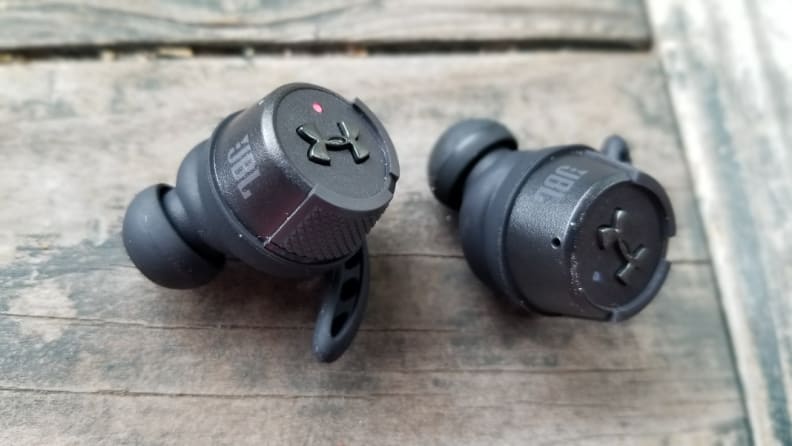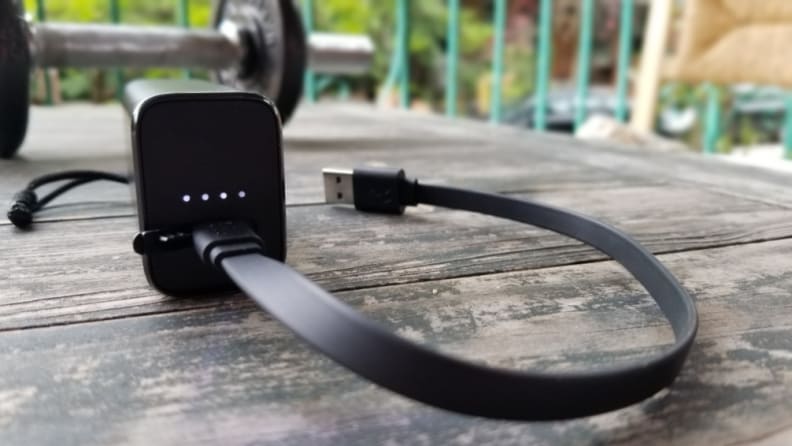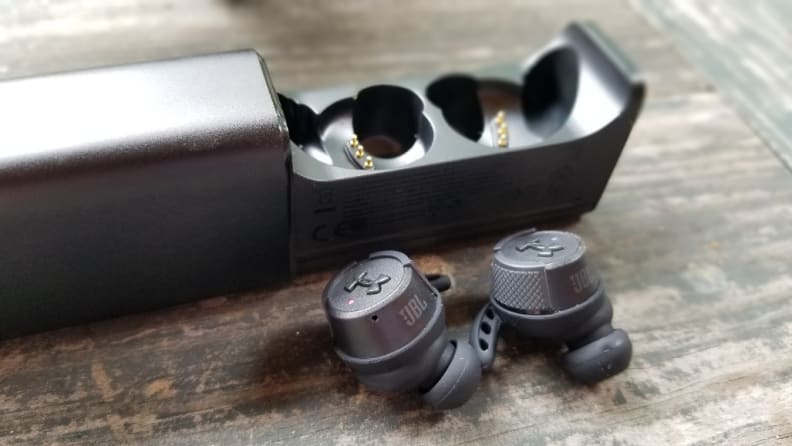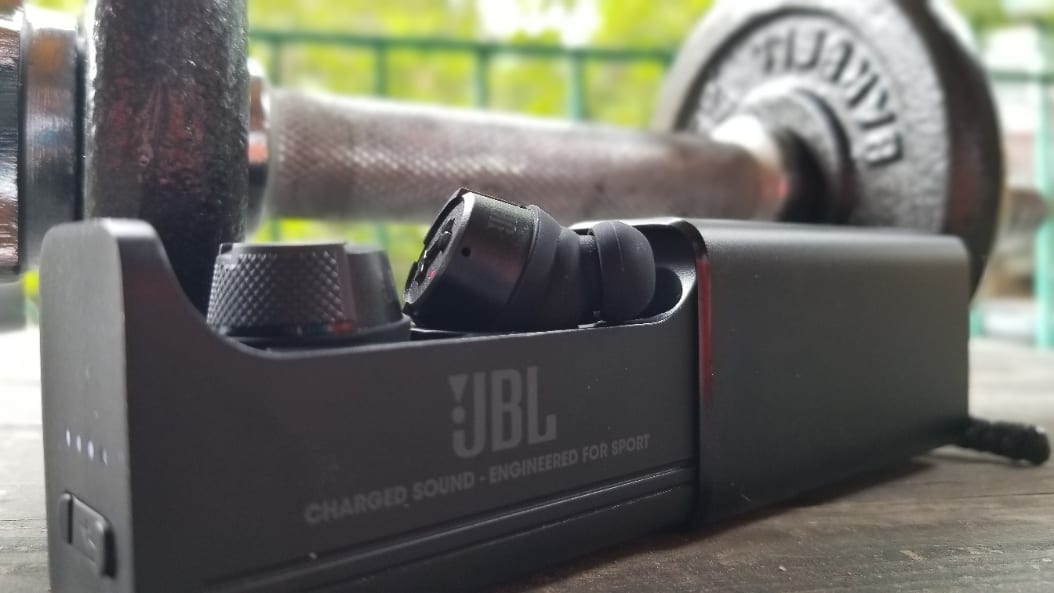Pros
-
Super durable
-
Excellent water resistance
-
Good battery life
Cons
-
Sound could be better for the price
-
Fit can be uncomfortable for some ears
The first thing folks interested in these true wireless buds need to understand is that, unlike a lot of true wireless options that have workout features tacked on, these earbuds are engineered from top to bottom with strenuous activity in mind. This makes for an altogether different approach to certain design elements and functionality that might even be seen as cons were you approaching these like standard true wireless earbuds.
The True Wireless Flash X are unequivocally awesome for workouts or jogging. They have multiple useful sound modes for hearing what's going on around you, and the earbuds and case are extremely robust and impact-resistant. They're a bit on the pricey side for headphones that might not be your go-to choice for non-workout situations, but if you've got the scratch and want a great pair of workout headphones, these are an excellent choice.
About the JBL x Under Armor True Wireless Flash X
These true wireless earbuds feature a combination of Under Armour's athletics-facing design aesthetics and JBL's penchant for balanced, rich sound quality. Here's what you need to know about them:
- Price: $169.95
- Battery life: up to 10 hours of playback time, up to 50 hours with charging case (4 full recharges)
- Rapid charging: 2 hours to full charge
- Colors: Black
- Connectivity: Bluetooth 5
- Dust/water resistance: IPX7
- Ear tips/wings: small, medium, and large ear tips and wings
- Weight: 16g
In the box, you're getting the True Wireless Flash X earbuds, their uniquely shaped charging case, a short USB-C charging cable, alternate sizes of the ear tips and stabilizing wings, and a quick start guide.
What We Like
Designed to work as hard as you do
This might sound like a marketing line, but it's true. The important thing to understand about the Under Armour/JBL True Wireless Flash X is that they're not—like many true wireless earbuds—just "capable" of being used during a workout. From the charging/carrying case to the earbuds, the Flash X are designed for a high impact existence replete with buckets of sweat.
Naturally, this includes an IPX7 rating (the "Ingress Protection" rating most oft-cited by headphones), which essentially means they're totally dunkable: you can submerge them in water up to one meter deep for around half an hour, so unless you're the sweatiest person in the galaxy, you won't have to worry about ruining them with your perspiration. The only knock here is that the "X" in that rating means there's no dust protection, so watch those desert marathons.
Where the Flash X really differentiate from the pack is in the details of their design. I would even argue that the design and physical components are the most important features. The earbuds (and stabilizing wings) have been carefully designed and constructed to be extremely firm and durable, and to that end are composed of a very firm but gently yielding rubber that makes for an extremely tight fit/seal.

The True Wireless Flash X—and the heavy-duty charging case—is designed to withstand grueling workouts.
This is kind of both a blessing and a curse, though. On one hand, the super tight fit/seal—which anyone should be able to achieve thanks to the included range of small, medium, and large ear tips and wings—is great both for keeping out exterior noise and for workout activities. Basically, you can jump around, drop to the ground, or do a cartwheel through a waterfall and these are staying put in your ears. The drawback is that the intense firmness just isn't super comfortable over time for me—but more on that below.
The robust design elements don't stop at the earbuds, either. The sleeve-style charging case, far from following the "pocketable" approach of most true wireless earbuds (where it aims to be as compact as possible), is actually quite heavy and stretches four inches long and two inches wide—there's essentially no way you're going to forget it's in your pocket. But it makes up for its size with sheer durability. Dressed in sturdy, impenetrable metal from corner to corner, it's easily the most durable and impact-ready case I've used.

Unlike most true wireless cases, the Flash X case is not very "pocketable." Instead, it's extremely robust and durable.
I'd have no qualms about chucking this thing into a locker or gym bag during the day after a workout—if anything, you should be worried about it breaking your other stuff!
Decent sound, but nothing to shout about
Considering how much effort went into the design of the earbuds and carrying case, it would be great if the audio quality was equally impressive, but it didn't blow me away. That's not to say the True Wireless Flash X don't sound good, but they just didn't overtly stand out, and they're also quieter than I expected.

The Flash X sound fine, but generally, sound quality—and overall volume—are not quite as good as other earbuds in this price range.
As usual, I did the majority of my listening over Spotify, but with these in particular I did a lot more walking, running, and jumping around than usual. While they faultlessly stayed planted in my ears through basically any activity, when I stopped testing the effects of impact and started just listening, I found myself a bit nonplussed. There's nothing unbalanced about the way the Flash X sound, buy they're also not headphones I would use in place of some of the cushier, more sound-forward headphones I already own.
Considering how good the seal is on these, you're getting plenty of bass and midrange support alongside treble frequencies, and generally folks won't be disappointed with how these earbuds sound. I just don't expect anyone (unless they've been exclusively listening to low end headphones) to have their jaw dropped.
Solid battery life
The battery life for the True Wireless Flash X is among the best you can get right now. In fact, the overall playback time has been doubled compared to the previous model. With about 10 hours of playback per charge, and an additional 40 hours from the hefty charging case you're getting as much as 50 hours of total playback time. In other words, more than double what you'll get from the AirPods and AirPods Pro.

The Flash X boast decent battery life at around 5 hours per charge, and an additional 20 via the charging case.
Given their obvious use case as workout headphones, most people should have enough battery life here for at least a couple full workout sessions without the case.
Good passive noise isolation and features
Even if the audio quality isn't class-leading, the features are relatively impressive. Again targeting their status as workout-facing headphones, JBL/Under Armour equipped the True Wireless Flash X with two "ambient" modes: TalkThru and Ambient Aware.
With TalkThru, which can be toggled by the controls on the headphones, music is dampened down and the ANC microphones are instead used to help amplify conversations, making it easier to, in JBL's words, "chat with a workout partner between sets," for example. With Ambient Aware, conversation is not the focal point, but a more general awareness of ambient surroundings, letting surround sounds (such as traffic) permeate awareness alongside your music.
Both of these settings work as they should and are easy to activate, but they're also very similar in their rendering of sound/ambient noise. It's nice to have the differentiation between them, but I feel like most people could get by with one or the other most of the time.
While they regretably don't include Active Noise Cancellation (not a huge surprise at this price), the Flash X do a really good job of keeping noise out. This is no-doubt thanks to the sheer tightness of their seal when you get a good earbud tip/wing combination in your ear. While walking outside, traffic like squealing breaks and even honking buses was noticeably dampened, almost inaudible. This also made me very appreciative of the Ambient Aware setting when I realized how dangerous the unnatural silence could be during outside jogging situations.
What We Don't Like
These don't go to 11
This may not be a drawback for everyone, but in my experience/opinion, the True Wireless Flash X aren't very loud. When I first used them, I ended up turning them all the way up while I was walking around. While my ears adjusted, I found myself missing that "slightly too loud" punch that I enjoy for certain types of music. Everything around me was silent thanks to the sealing and ANC on display from these headphones, but the music still felt a bit, for lack of a better word, wimpy.
This situation likely isn't a problem if you're using these headphones strictly for jogging or workout scenarios, where active listening is not a priority, but if you like your music a bit louder than average, you may find yourself disappointed by the maximum volume available here.

The Flash X sound just fine, but they're not very loud—a drawback for some.
Fairly expensive for specialist headphones
At $170, the True Wireless Flash X aren't cheap. While they're not overpriced, the truth is that a huge majority of what you're paying for—the workout-focused design elements, and "Bionic Hearing" modes—are engineered with workouts first and everything else second.
This, coupled with the lack of loudness and decent-but-not-amazing sound make it unlikely that these headphones would be a great choice as a primary set of generalist earbuds for many. So while they're not overpriced, per se, they are fairly expensive for a set that are more likely to be used primarily during specialist scenarios.
Not always a picture of comfort
It may be that I'm biased having recently reviewed Sony's extremly comfy WH-1000XM4 flagship over-ear headphones, but I found the Flash X's super tight fit to be a bit uncomfortable, at least at first.

The Flash X aren't uncomfortable, per se, but they're so firm and tight-sealing in your ears that they actually feel better in the middle of a workout than for more casual use.
How they feel and how long you can wear them depends a lot on how you're using them, however. As I've said above, they're very firm, even the parts that touch your ears, but this phenomenon is also tempered by the unavoidable sweating that people are going to do during workout situations. The Flash X are basically designed to be resilient and firm enough to stay put given the addition of sweating and impactful activity, but this means that when you're bone dry and lazing about, they feel a bit too tough.
Is this a drawback? It's hard to say, given that it would be a drawback that's integral to the headphones' design. However, it's a point of contention that's worth noting for any interested buyers.
No on-set volume controls
This is a tiny nitpick for some people, but for others, it's a deal-breaker: volume controls. You can obviously adjust the volume for the Flash X on your smartphone, tablet, or laptop—whatever the source device is—but there's no way to adjust volume on the earbuds themselves. If you hate fishing your phone out of your pocket to adjust volume, you might find the Flash X a bit frustrating.
Should You Buy It?
Yes—if you're serious about exercise
My time with the JBL/Under Armour True Wireless Flash X made it very clear that while these earbuds don't do everything, they do one thing—serving as a robust workout companion—extremely well. For a lot of folks, spending more than $100 on headphones seems crazy. However, if you've already reached the promised land of understanding that spending more on something you use every day of your life is worthwhile (hello, mattresses), you may understand why plenty of people are willing to spend $150 or $200 on headphones. The Flash X fulfill that niche, albeit primarily in the realm of workout headphones.
You could use these for every headphone situation, sure, but that's really not what they're designed for. If you work out hard enough that you're worried about damaging your less-robust headphones, or are committed enough to buying a specialty product, however, these are an awesome choice.
Just keep in mind that if you're looking for more general purpose true wireless buds, there may be something slightly less specialized that would suit you better. For example, the Samsung Galaxy Buds+ are more affordable at around $150, are still workout-compatible (though not nearly as durable as the Flash X), and are generally more comfortable to wear. You could also spend just a little more on the excellent Jabra Elite Active 75t, which deliver a more traditional tiny charging case, faster rapid charging, and an IP57 rating, which means they're dust-resistant as well as dunkable.
The Flash X may be less generalist and occasionally a bit uncomfortable, but they make up for it in terms of sheer staying power, offering the tightest seal I've seen in a pair of true wireless buds, which leads to great noise isolation, a high amount of confidence during high-impact workouts, and—combined with the fully aluminum charging case—a product that should be able to withstand even the most grueling situations. If this is what you need, the Flash X might just be the saviors of your workout universe.
Meet the tester
Lee was Reviewed's point person for most television and home theater products from 2012 until early 2022. Lee received Level II certification in TV calibration from the Imaging Science Foundation in 2013. As Editor of the Home Theater vertical, Lee oversaw reviews of TVs, monitors, soundbars, and Bluetooth speakers. He also reviewed headphones, and has a background in music performance.
Checking our work.
Our team is here to help you buy the best stuff and love what you own. Our writers, editors, and experts obsess over the products we cover to make sure you're confident and satisfied. Have a different opinion about something we recommend? Email us and we'll compare notes.
Shoot us an email

